Iron-Rich Spherules of Taihu Lake: Origin Hypothesis of Taihu Lake Basin in China
Abstract
:1. Introduction
2. Geological Background and Experimental Methods
2.1. Geological Background and Sampling Location
2.2. Experimental Methods
3. Results
3.1. Occurrence and Distribution of Iron-Rich Spherules
3.2. Morphological Characteristics of Iron-Rich Spherules
3.3. Microscopic Observation Data
3.3.1. XRD Analysis of Iron-Rich Spherules
3.3.2. Micro-Textures of Iron-Rich Spherules
3.3.3. EPMA Data
3.3.4. TEM Data and C Bits
4. Discussion
4.1. Iron-Rich Spherules Occurring in A Marker Silty Layer
4.2. Iron-Rich Spherules Are Not Iron-Manganese Nodules
4.3. Iron-Rich Spherules Are Aerosol Products Rather Than Hydrosol Products
4.4. Origin of The Iron-Rich Spherules and Airburst Plume
Author Contributions
Funding
Acknowledgments
Conflicts of Interest
References
- Chen, J.; Yu, Z.; Yun, C. The development of the Yangtze river delta’s landscape. Acta Geogr. Sin. 1959, 25, 201–220. [Google Scholar]
- Huang, D.; Yang, S.; Liu, Z.; Mei, Z. Geological studies of the formation and development of the three large fresh-water lakes in the lower Yangtze valley. Oceanol. Limnol. Sin. 1965, 7, 396–426. [Google Scholar]
- Sun, S.; Huang, Y. Taihu Lake; Ocean Press: Beijing, China, 1993; pp. 23–32. [Google Scholar]
- Shen, Z. Volcanic explosion-effusion and formation of Taihu Lake. Earth Sci. J. China Univ. Geosci. 2003, 28, 441–444. [Google Scholar]
- Jiang, J.; Dou, H.; Su, S. Freshwater Lake Groups in the Middle and Lower Reaches of the Yangtze and Huaihe River; Changjiang Publishing House: Wuhan, China, 2009; pp. 124–169. [Google Scholar]
- Sun, S.; Wu, Y. The formation and modern sedimentation of Taihu Lake. Sci. China Ser. B 1987, 12, 1329–1339. [Google Scholar]
- He, Y.; Xu, D.; Lu, D.; Shen, Z.; Lin, C.; Shi, L. Preliminary study on the origin of Taihu Lake: Inference from shock Deformation features in Quartz. Chin. Sci. Bull. 1991, 36, 847–850. [Google Scholar]
- Yang, Z.; Xu, D. Some super-microstructures in quartz grains from the Taihu Lake region, China, and their genetic significance. Sci. Geol. Sinca 1993, 28, 161–168. [Google Scholar]
- Wang, E.; Zhu, Z.; Zhang, H.; Cao, H. Discovery of shatter cones at Jueshan Island, Taihu Lake. Chin. Sci. Bull. 1994, 39, 1210–1214. [Google Scholar]
- Wang, E.; Sharpton, V.L.; Burke, K.; Wan, Y.; Shi, Y. Discovery of shock metamorphic quartz at Taihu Lake Zeshan island and its implications. Chin. Sci. Bull. 1994, 39, 419–423. [Google Scholar]
- Wang, E.; Wan, Y.; Xu, S. Discovery and implication of shock metamorphic unloading microfractrues in Devonian bedrock of Taihu Lake. Sci. China Ser. D 2002, 45, 459–467. [Google Scholar]
- Wang, H.; Xie, Z.; Qian, H. Discovery of Impact ejecta from Taihu Lake impact crater. Geol. J. China Univ. 2009, 15, 437–444. [Google Scholar]
- Dong, Y.; Xie, Z.; Zuo, S. The Deformation Features of Quartz grains In the Sandstone of Taihu Area:Taihu Impact Origin Controversy. Geol. J. China Univ. 2012, 18, 395–403. [Google Scholar]
- Zuo, S.; Xie, Z. Mineralogical study of iron-rich elongated concretions in Holence silt layer in Taihu Lake region. Geol. J. China Univ. 2021, 27, 172–182. [Google Scholar]
- Yuan, Y.; Li, C.; Zuo, S.; Sheng, X.; Lin, C.; Xie, Z. Holocene sedimentary characteristics of the core YLL1 of Taihu Lake revealing evolution history of Taihu Lake basin. Quat. Sci. 2019, 39, 1133–1147. [Google Scholar]
- Chang, W.Y.B.; Xu, X.; Yang, J.; Liu, J. Evolution in Taihu Lake ecosystem as evidence of changes in sediment profiles. J. Lake Sci. 1994, 3, 217–226. [Google Scholar] [CrossRef] [Green Version]
- Hong, X. Origin and evolution of the Taihu Lake. Mar. Geol. Quat. Geol. 1991, 4, 87–99. [Google Scholar]
- Wang, Y.; Wang, J.; Liu, J.; Chang, W.Y.B. Evolution of sedimentary environment of a Holocene river channel in east Taihu lake. Acta Palaeontol. Sin. 1996, 2, 224–233. [Google Scholar]
- Jing, C. The fresh-water lakes in the middle and lower Yangtze valley. Sci. Geogr. Sin. 1985, 5, 227–234. [Google Scholar]
- Sun, S. Does the Taihu Lake plain have Holocene transgression? Acta Oceanol. Sin. 1992, 14, 69–77. [Google Scholar]
- Liu, J.; Chang, W.Y.B. Uses of pollen profiles to show the last 12,000 years of environmental changes in the Yangtze river delta. Acta Palaeontolgica Sin. 1996, 35, 136–154. [Google Scholar]
- Yang, H.; Chen, X. Quaternary sea surface rise and fall in eastern China. Mar. Quat. Geol. 1985, 5, 59–80. [Google Scholar]
- Wang, B. Discussion on the Change of Sea Level and Coastal Line in Quaternary Period. J. Shanghai Norm. Univ. Nat. Sci. Ed. 1978, 1, 65–78. [Google Scholar]
- Zuo, S. Study on the Origin of Iron-Rich Concretions in the Holocene Silty Layer of Taihu Lake: Implication for the Origin of Taihu Lake Basin; Nanjing University: Nanjing, China, 2020. [Google Scholar]
- Lee, S.; Xu, H. XRD and TEM studies on nanophase manganese oxides in freshwater ferromanganese nodules from Green Bay, Lake Michigan. Clays Clay Miner. 2016, 64, 523–536. [Google Scholar] [CrossRef]
- Lee, S.; Shen, Z.; Xu, H. Study on nanophase iron oxyhydroxides in freshwater ferromanganese nodules from Green Bay, Lake Michigan, with implications for the adsorption of As and heavy metals. Am. Mineral. 2016, 101, 1986–1995. [Google Scholar] [CrossRef]
- Liu, H. Structural Evolution of Thermally Treated Al-Substituted Goethite and its Response of Surface Reactivit; Hefei University of Technology: Hefei, China, 2013. [Google Scholar]
- Xie, Z.; Zuo, S. The Occurrences of Taihu Lake Iron-Rich Concretions Indicate Their Formation Relating to Airburst Fallout Deposition Rather than Groundwater Colloidal Deposition. In 47th Lunar and Planetary Science Conference; Lunar and Planetary Institute: Houston, TX, USA, 2016; Abstract #2398. [Google Scholar]
- Tan, W. The Composition and Surface Chemistry Characteristics of Fe-Mn Nodules of Soils in China; Huazhong Agricultural University: Wuhan, China, 2000. [Google Scholar]
- White, G.N.; Dixon, J.B. Iron and manganese distribution in nodules from a young Texas vertisol. Soil Sci. Soc. Am. J. 1996, 60, 1254–1262. [Google Scholar] [CrossRef]
- Huang, Z.; Liu, G. “Impact ejecta in Taihu area” revisted: Evidence from ferruginous concretions in modern sediments of Taihu Lake area. Geol. J. China Univ. 2012, 18, 379–389. [Google Scholar]
- Raiswell, R.; Fisher, Q.J. Mudrock-hosted carbonate concretions:a review of growth mechanisms and their influence on chemical isotopic composition. J. Geol. Soc. 2000, 157, 239–251. [Google Scholar] [CrossRef]
- Fisher, R.V. Proposed classification of volcaniclastic sediments and rocks. Aust. Vet. J. 1961, 72, 1409–1414. [Google Scholar] [CrossRef]
- Warme, J.E.; Kuehner, H.C. Anatomy of an anomaly: The Devonian catastrophic Alamo impact breccia of southern Nevada. Int. Geol. Rev. 1998, 40, 189–216. [Google Scholar] [CrossRef]
- Warme, J.E.; Morgan, M.; Kuehner, H.C. Impact-generated carbonate accretionary lapilli in the Late Devonian Alamo Breccia. Spec. Pap. Geol. Soc. Am. 2002, 356, 489–504. [Google Scholar]
- Pope, K.O.; Ocampo, A.C.; Fischer, A.G.; Alvarez, W.; Fouke, B.W.; Webster, C.L.; Vega, F.J.; Smit, J.; Fritsche, A.E.; Claeys, P. Chicxulub impact ejecta from Albion Island, Belize. Earth Planet. Sci. Lett. 1999, 170, 351–364. [Google Scholar] [CrossRef]
- Yancey, T.E.; Guillemette, R.N. Carbonate accretionary lapilli in distal deposits of the Chicxulub impact event. Geol. Soc. Am. Bull. 2008, 120, 1105–1118. [Google Scholar] [CrossRef]
- Chouet, B.; Hamisevicz, N.; Mcgetchin, T.R. Photoballistics of volcanic jet activity at Stromboli, Italy. J. Geophys. Res. 1974, 79, 4961–4976. [Google Scholar] [CrossRef]
- Ripepe, M.; Rossi, M.; Saccorotti, G. Image processing of explosive activity at Stromboli. J. Volcanol. Geotherm. Res. 1993, 54, 335–351. [Google Scholar] [CrossRef]
- Patrick, M. The gas content and buoyancy of Strombolian ash plumes. J. Volcanol. Geotherm. Res. 2007, 166, 1–6. [Google Scholar] [CrossRef]
- Harris, A.J.L.; Donne, D.D.; Dehn, J.; Ripepe, M.; Worden, A.K. Volcanic plume and bomb field masses from thermal infrared camera imagery. Earth Planet. Sci. Lett. 2013, 365, 77–85. [Google Scholar] [CrossRef] [Green Version]
- Pope, K.O.; Ocampo, A.C.; Fischer, A.G.; Vega, F.J.; Ames, D.E.; King, D.T.; Fouke, B.W.; Wachtman, R.J.; Kletetschka, G. Chicxulub impact ejecta deposits in southern Quintana Roo, México, and central Belize. Spec. Pap. Geol. Soc. Am. 2005, 384, 171–190. [Google Scholar]
- Isabel, I.A.; Bischoff, J.L.; Gabriela, D.V.; Li, H.; Decarli, P.S.; Bunch, T.E.; Wittke, J.H.; Weaver, J.C.; Firestone, R.B.; Allen, W. Evidence from central Mexico supporting the Younger Dryas extraterrestrial impact hypothesis. Proc. Natl. Acad. Sci. USA 2012, 109, 4723–4724. [Google Scholar]
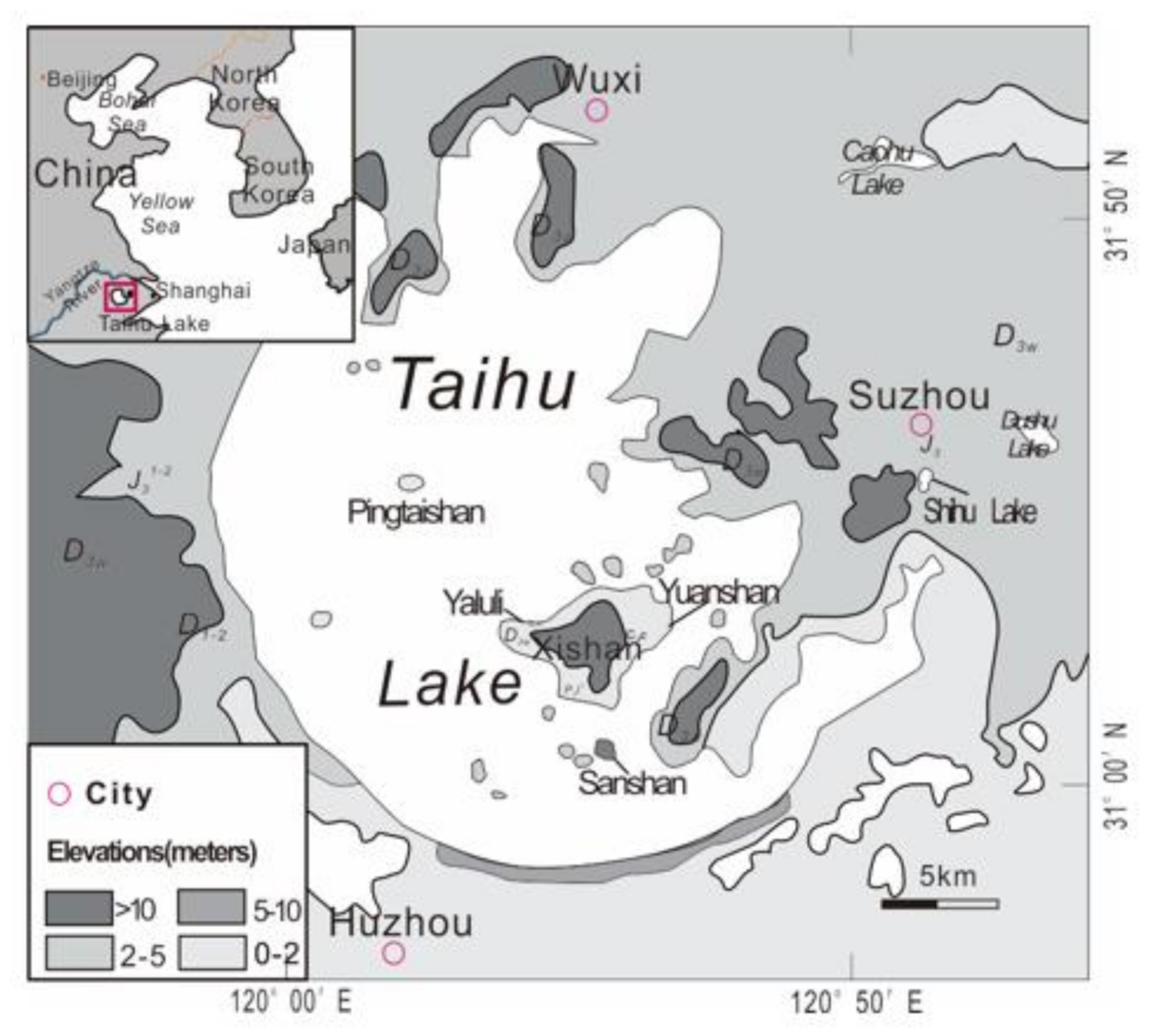
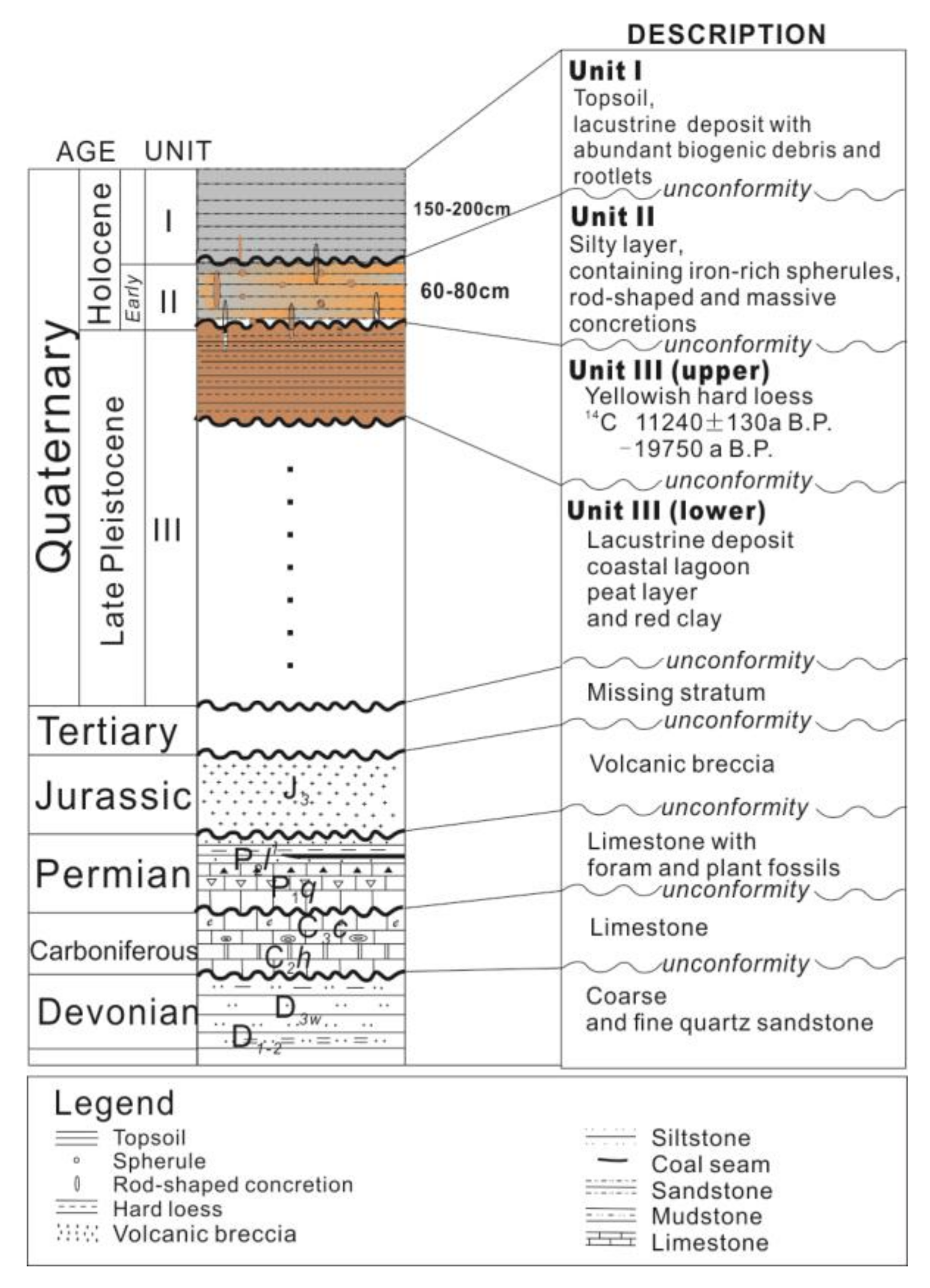
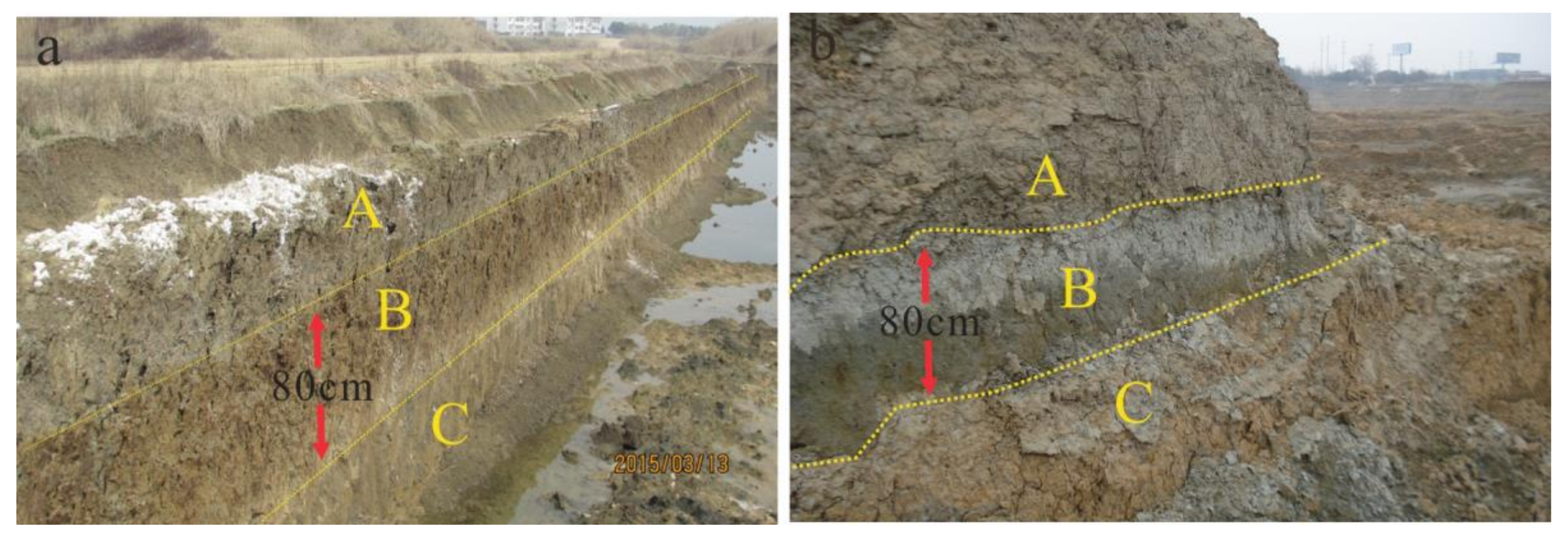
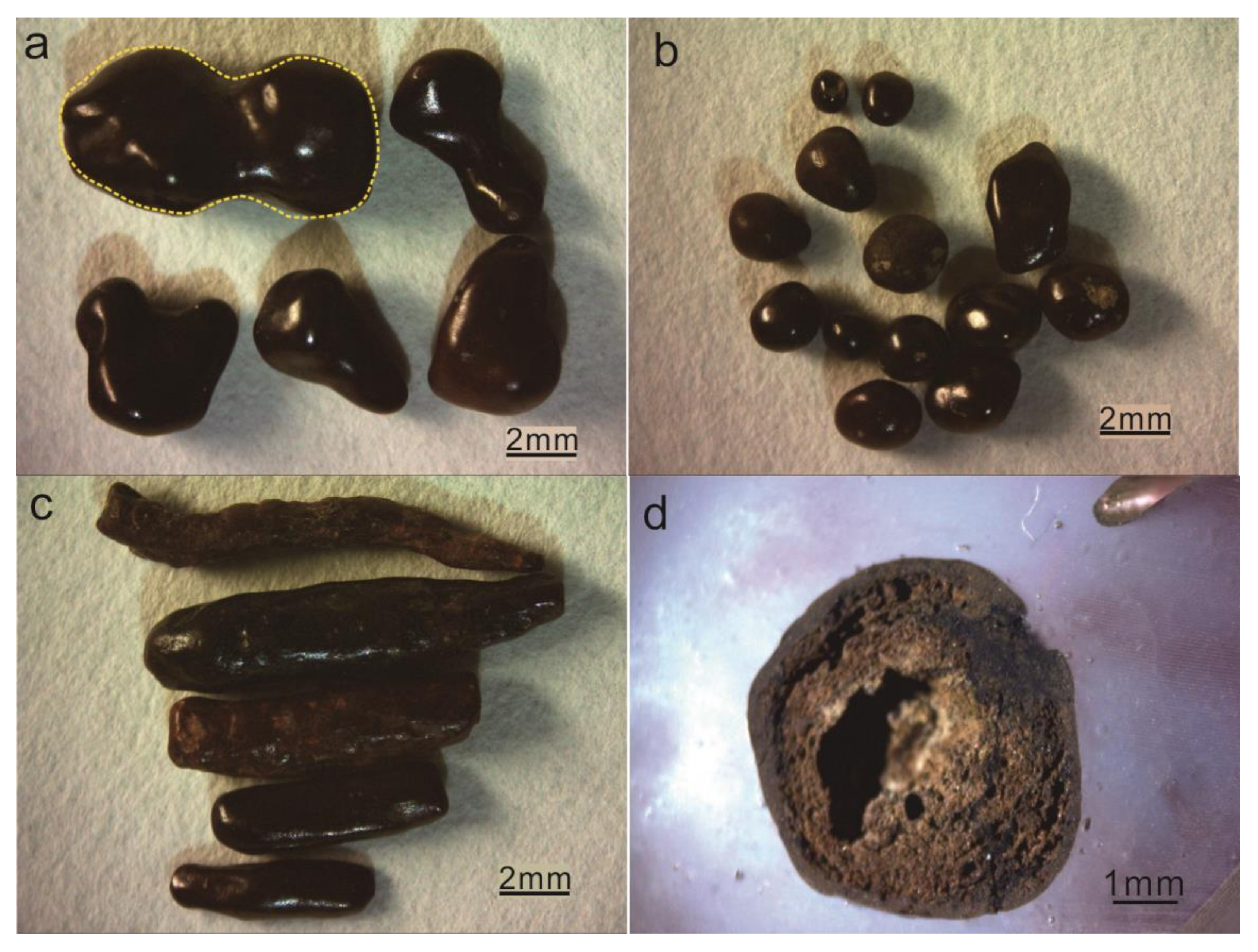
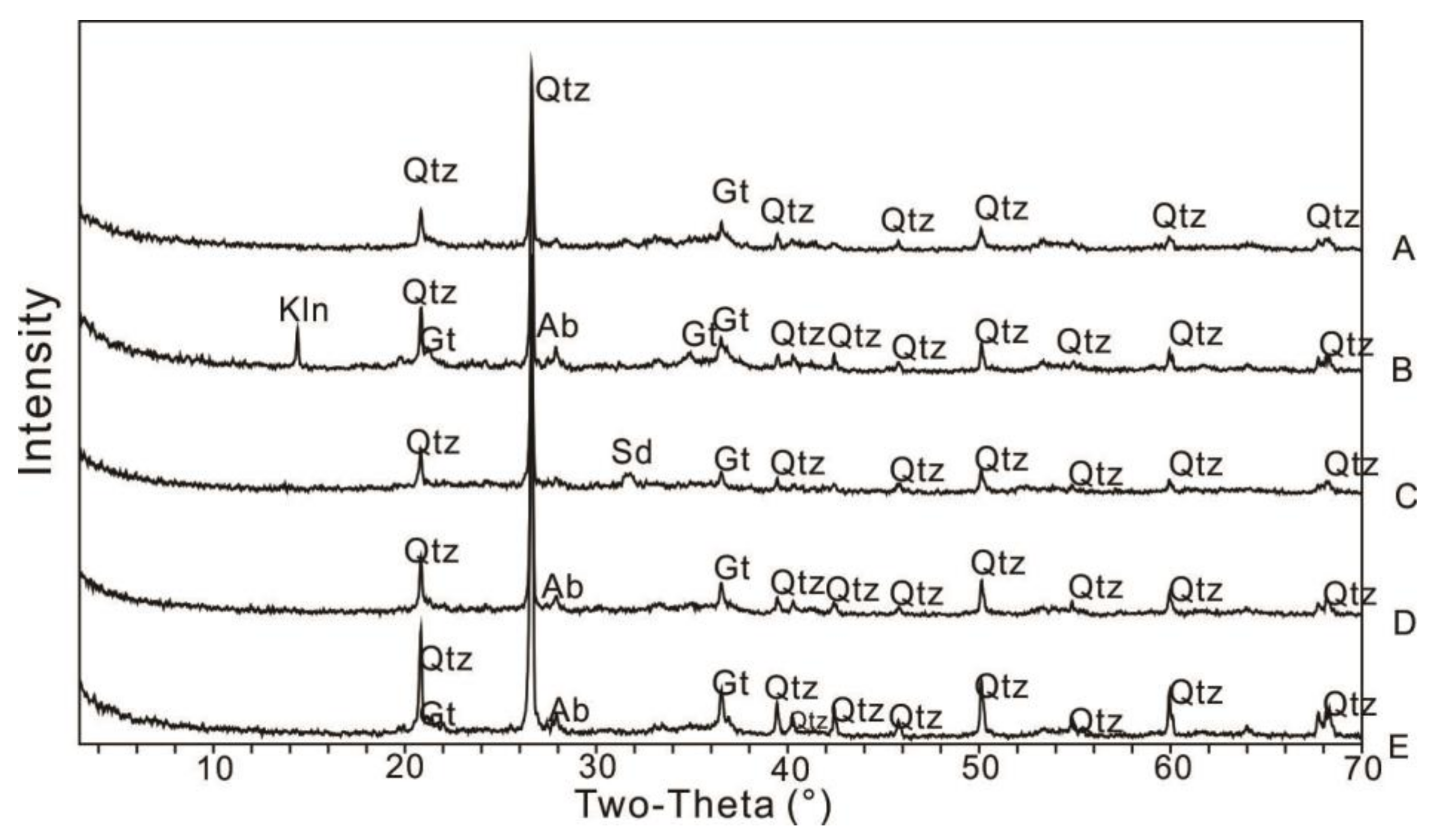
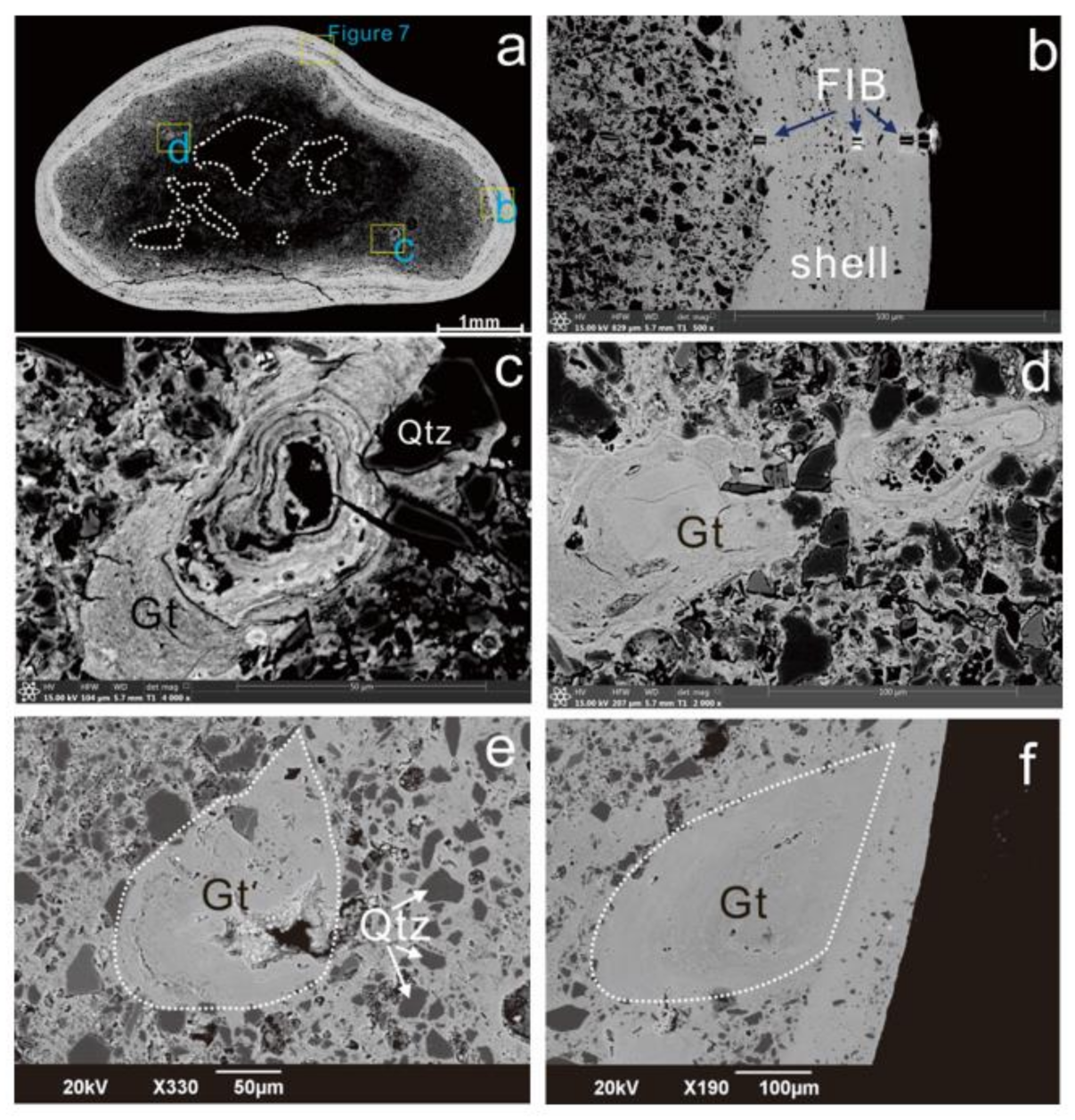
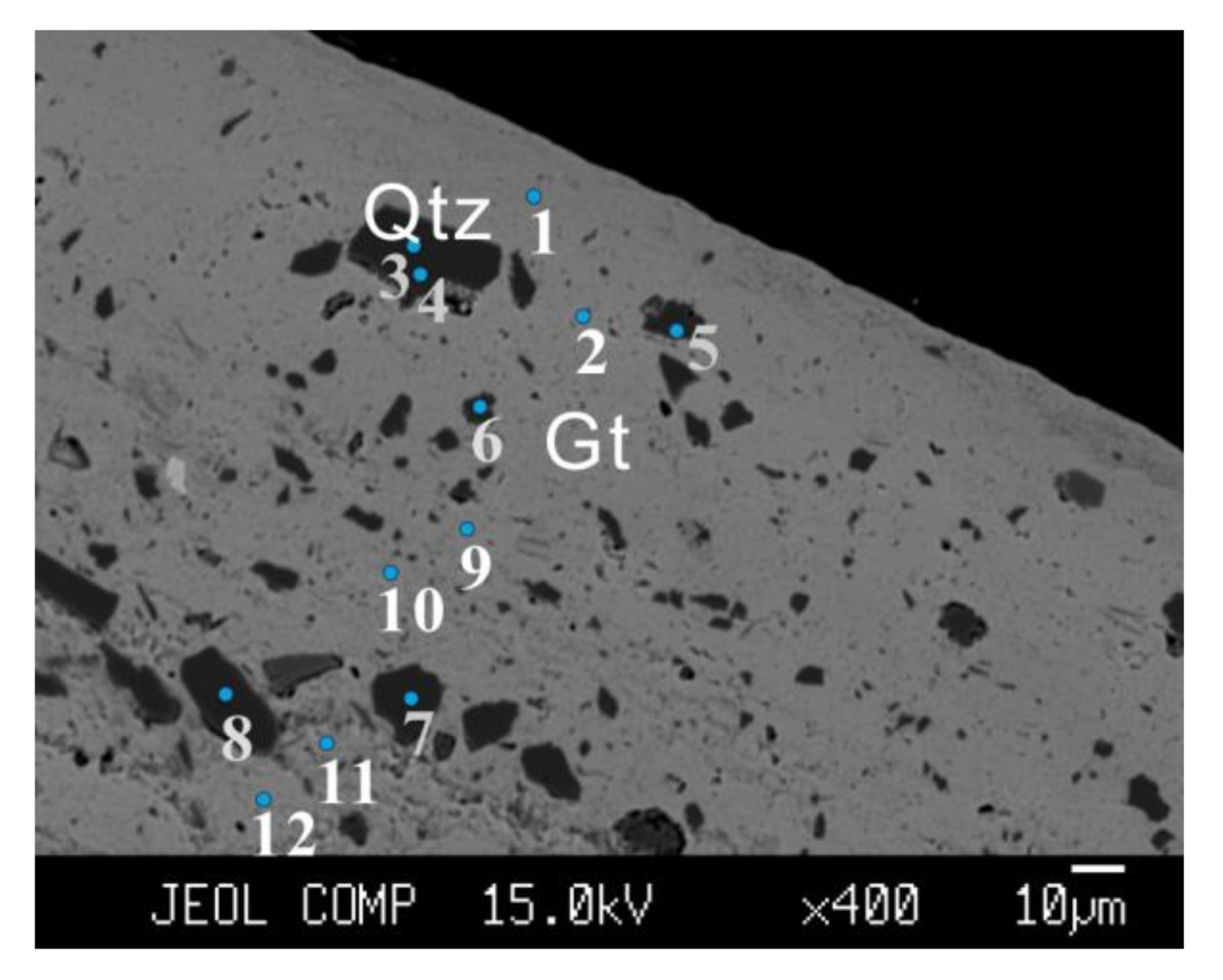
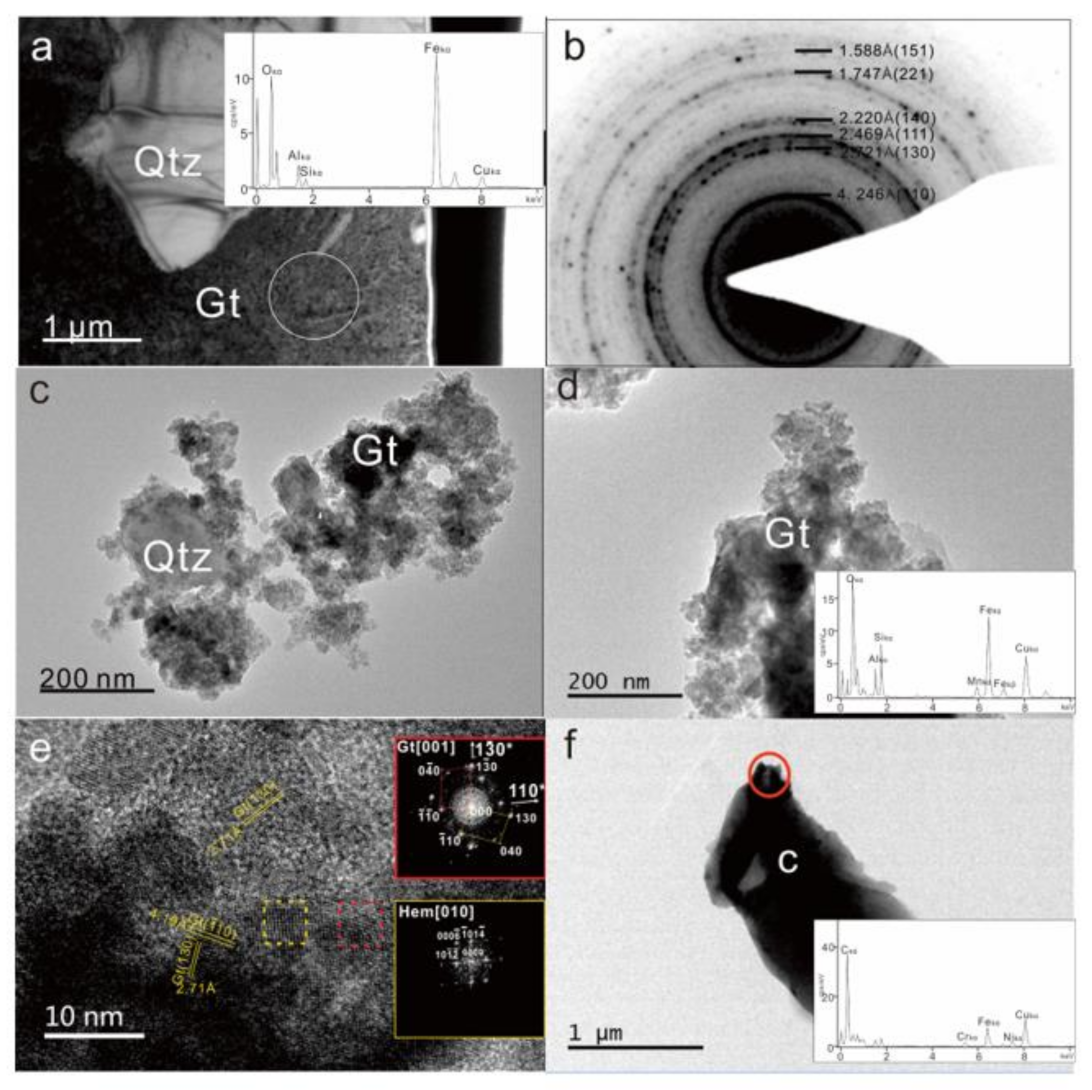
| Element | 1 (Gt) | 2 (Gt) | 3 (Qtz) | 4 (Qtz) | 5 (Qtz) | 6 (Qtz) | 7 (Qtz) | 8 (Qtz) | 9 (Gt) | 10 (Gt) | 11 (Gt) | 12 (Gt) |
|---|---|---|---|---|---|---|---|---|---|---|---|---|
| K2O | 0.05 | 0.06 | 0.01 | 0.01 | 0.00 | 0.01 | 0.00 | 0.00 | 1.05 | 0.98 | 0.99 | 1.99 |
| MgO | 0.03 | 0.06 | 0.00 | 0.00 | 0.00 | 0.00 | 0.00 | 0.00 | 0.37 | 0.38 | 0.00 | 0.00 |
| FeO | 71.26 | 72.43 | 1.29 | 1.47 | 1.60 | 1.33 | 1.33 | 1.30 | 60.86 | 62.66 | 58.36 | 50.51 |
| CaO | 0.06 | 0.03 | 0.00 | 0.00 | 0.00 | 0.00 | 0.00 | 0.00 | 0.10 | 0.11 | 0.00 | 0.00 |
| Al2O3 | 7.60 | 7.49 | 0.00 | 0.00 | 0.03 | 0.08 | 0.12 | 0.02 | 11.73 | 12.18 | 13.51 | 16.17 |
| MnO | 0.14 | 0.13 | 0.00 | 0.00 | 0.01 | 0.00 | 0.01 | 0.01 | 0.17 | 0.14 | 0.09 | 0.10 |
| TiO2 | 0.08 | 0.18 | 0.00 | 0.00 | 0.00 | 0.00 | 0.00 | 0.07 | 0.25 | 0.23 | 0.27 | 0.36 |
| SiO2 | 4.15 | 2.56 | 90.52 | 95.66 | 90.98 | 90.94 | 90.73 | 92.25 | 13.00 | 14.00 | 16.28 | 20.66 |
| P2O5 | 0.84 | 0.83 | 0.00 | 0.04 | 0.00 | 0.00 | 0.01 | 0.01 | 0.49 | 0.52 | 0.00 | 0.00 |
| ZrO2 | 0.03 | 0.04 | ||||||||||
| Total (wt.) | 84.19 | 83.76 | 91.82 | 97.17 | 92.62 | 92.35 | 92.21 | 93.66 | 88.02 | 91.19 | 89.54 | 89.83 |
Publisher’s Note: MDPI stays neutral with regard to jurisdictional claims in published maps and institutional affiliations. |
© 2021 by the authors. Licensee MDPI, Basel, Switzerland. This article is an open access article distributed under the terms and conditions of the Creative Commons Attribution (CC BY) license (https://creativecommons.org/licenses/by/4.0/).
Share and Cite
Zuo, S.; Xie, Z. Iron-Rich Spherules of Taihu Lake: Origin Hypothesis of Taihu Lake Basin in China. Minerals 2021, 11, 632. https://doi.org/10.3390/min11060632
Zuo S, Xie Z. Iron-Rich Spherules of Taihu Lake: Origin Hypothesis of Taihu Lake Basin in China. Minerals. 2021; 11(6):632. https://doi.org/10.3390/min11060632
Chicago/Turabian StyleZuo, Shuhao, and Zhidong Xie. 2021. "Iron-Rich Spherules of Taihu Lake: Origin Hypothesis of Taihu Lake Basin in China" Minerals 11, no. 6: 632. https://doi.org/10.3390/min11060632
APA StyleZuo, S., & Xie, Z. (2021). Iron-Rich Spherules of Taihu Lake: Origin Hypothesis of Taihu Lake Basin in China. Minerals, 11(6), 632. https://doi.org/10.3390/min11060632






